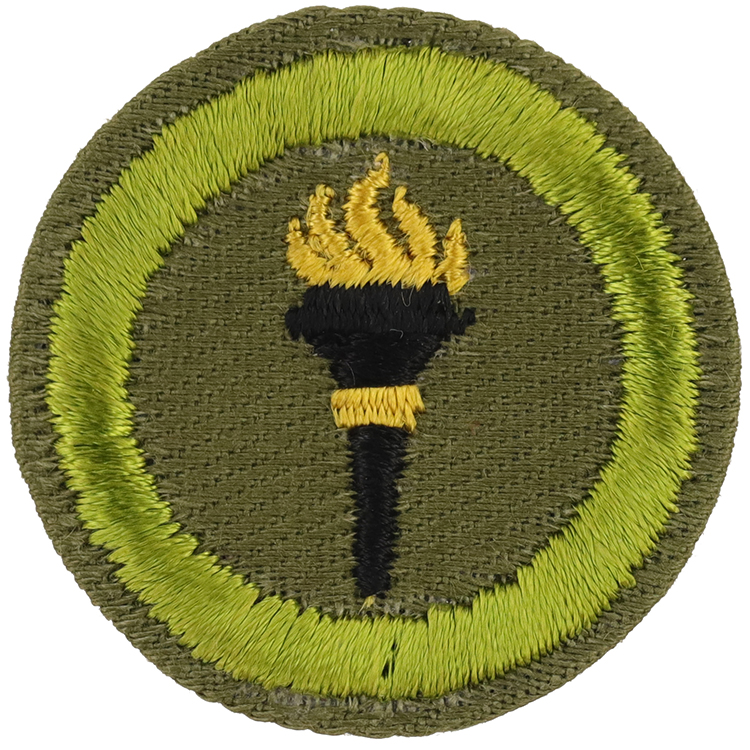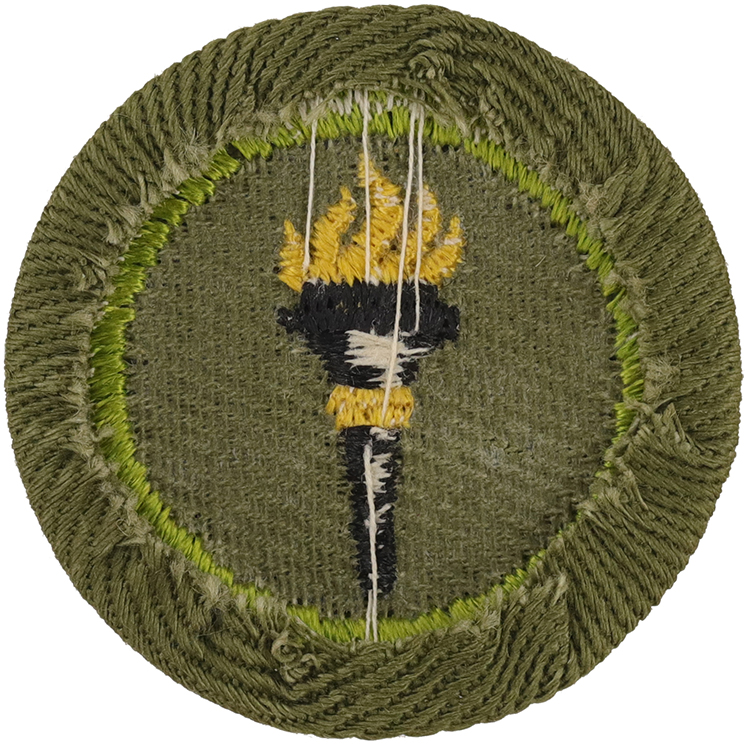
Fig. 1: PubHea-E2-Front
- Cloth: Khaki right twill
- Embroidery: Cotton lock stitch

Fig. 2: PubHea-E2-Reverse
- Back: Plain NO imprint with starch
Item Name: Public Health 1947 - 1960
Item ID: PubHea-E2
Collector Rating: 1
Requirements March 1931 until June 1948
1. State the chief causes and modes of transmission of each of the following diseases: Tuberculosis, typhoid fever, diphtheria, malaria, hookworm disease.
2. Draw a diagram showing how the house-fly carries disease.
3. State the precautions which should be taken to prevent the spread of contagious disease during the sickness of the patient and following his removal or recovery.
4. Describe good methods by which a community may dispose of garbage and sewage, and may obtain a safe water supply, and tell what methods are used in his own community or on his own premises.
5. State the precautions which must be taken in producing and handling milk to make it as safe as possible from a health standpoint, and tell what the local laws require in this respect, and the extent to which they are enforced.
6. Tell how to plan and manage a small camp in a sanitary way.
7. State the reasons why school children should undergo a medical examination.
8. Tell how he may cooperate with the health authorities in preventing disease.
9. Describe different ways in which a person may become immune to infectious diseases.
10. Produce satisfactory evidence that he has rendered service in some effort recommended by the public health authorities in the interest of public health.
Requirements June 1948 until January 1957
1. Tell the chief cause of the following diseases, and how to prevent its spread: tuberculosis, typhoid fever, diphtheria, malaria, hookworm, Rocky Mountain spotted fever, tetanus (lockjaw), and rabies.
2. (a) Make, bait, and set a fly trap; bring it in with captured evidence that it will work. OR if there are no flies nearby, explain how flies may be controlled and their breeding places destroyed. (b) name two or more diseases known to be carried from one person to another by flies.
3. Give five simple rules for preventing the spread of communicable diseases during and following the illness of a patient.
4. Destroy completely two pounds (2 quarts) of "green" garbage over embers of an outdoor cooking fire.
5. (a) Tell what health requirements his community enforces in the safe production and handling of milk; (b) describe how milk is protected in his home; (c) Make a quart of raw milk safe to drink. (If raw milk is not available, demonstrate with pasteurized milk.)
6. Dig and make ready for use: (a) straddle trench latrine; (b) "cat" hole latrine. Then fill in and leave them in condition so that they will not cave in.
7. Explain two purposes of the "recheck" examination given to Scouts by a medical doctor when they arrive at a Council Camp.
8. Tell how he may cooperate with the health authorities in preventing disease in his home or community.
9. (a) Filter one full canteen of muddy water, using material he carries with him or can find where he camps; (b) make one-half the water safe for drinking by using a suitable chemical, the other half by heating.
10. Name diseases against which he has been protected by vaccination or other method and explain how the protection works
Requirements January 1957 until September 1962
1. Tell how people contract five of the following diseases and what you and the health department can do to prevent their spread: typhoid fever, diphtheria, malaria, hookworm, Rocky Mountain spotted fever, tetanus (lockjaw), rabies, whooping cough, scarlet fever, tuberculosis, smallpox.
2. (a) Name two diseases common to animal and man that can be caught by a person through the drinking of unpasteurized milk. (b) Name two diseases that can be caught by drinking polluted water. (c) Name two diseases that can be spread by rats.
3. Explain how flies may be controlled and their breeding places destroyed.
4. Name three diseases against which an infant should be immunized and two diseases against which boys of Scout and Explorer age should be immunized.
5. Do two of the following: (a) Visit your state, county, or local health department and prepare an outline of its principal functions. (b) Visit your water treatment plant and prepare an outline of the major steps in the water treatment used to protect your community from diseases that may be spread by water. (c) Prepare a simple sketch of a home sewage disposal system and tell how it should be located and constructed to protect against the pollution of nearby wells or springs. (d) Visit a dairy farm and prepare an outline of the measures taken to produce clean milk for pasteurization. (e) Visit a milk pasteurization plant and prepare a brief statement on the pasteurization of milk. (f) Visit your community sewage treatment plant and prepare a brief statement about sewage disposal.
6. Do the following: (a) Filter one full canteen of muddy water, using clean cloth or other materials, and then make the water safe for drinking either by treatment with suitable chemical or by boiling water. (b) Dig and make ready for use either a straddle trench latrine or a "cathole" latrine; then fill in properly. (c) Properly dispose of garbage and rubbish from a camp site. (d) Describe how milk could be pasteurized in your home and make a quart of raw milk safe to drink.
7. Explain two purposes of the "recheck" examination given to Scouts by a medical doctor when they arrive at a council camp.


